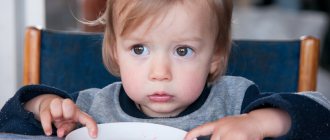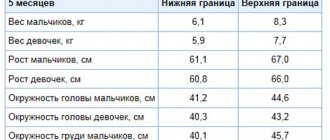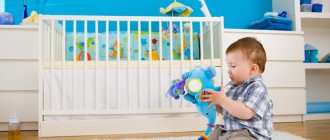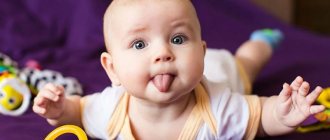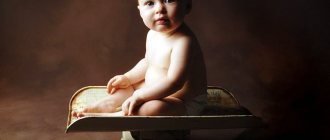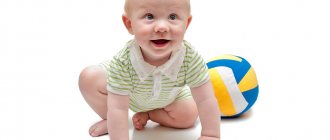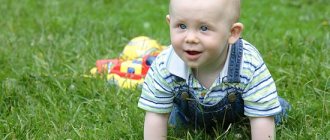Our children are growing very quickly. Watching a little man is not only interesting, but also useful. After all, this will help to identify and promptly eliminate developmental delays.
See, a detailed calendar of child development from birth to 3 years by month
Each age of the baby should correspond to certain successes. What should your child know and be able to do at 1 year and 11 months?
What can a baby do?
- At this age, the child is very mobile , he not only stands well on his feet, but also runs, jumps, spins, and, therefore, often falls. If the baby hears rhythmic music, he dances, waves his arms, and can even sing along.
- At 1 year and 11 months, a child can build a tower of cubes and throw a ball at a target, which indicates that the baby has learned to control his fingers well.
- Children at this age may show interest in a bicycle; they press the pedals, but are not yet able to turn them. But the child can already cope with riding a scooter.
- By this age, the baby can put on socks and pants on his own, and some even manage to cope with simple fasteners on things.
- The child can now use the potty independently.
- As a rule, at this time it becomes clear which hand the baby has dominant - right or left.
Reference! Psychologists do not advise retraining a child if he uses his left hand more actively.
Watch another useful video:
Neuropsychic development of a child at one and a half years old
It is not difficult to determine whether neuropsychic development has deviated from the norm; it is important to carefully observe the character and behavior for several days. Baby skills that correspond to the norm:
- shows interest in examining the room, tries to look into all the nooks and crannies;
- loves to play hide and seek with adults;
- knows how to sort toys by shape, color, size;
- stacks pyramids;
- knows how to distinguish body parts, points with a finger or touches with a hand when he hears a name from his parents;
- learns to find familiar pictures in books; at the request of his parents, he shows a dog, a cat, a bunny.
You need to be wary if a child has difficulty walking, does not respond to the speech of adults, or does not even notice the absence of one of the parents. In such cases, it is recommended to go to the pediatrician and explain the behavior of your son or daughter.
Features of the psycho-emotional sphere
- In a child aged 1 year and 11 months, the psychological sphere continues to actively develop, but this happens a little slower than it was in the first year of life. The duration of wakefulness increases to 4-5 hours.
- The baby becomes more independent and begins to show his character.
- Some children are capricious - they purse their lips if they don’t want to brush their teeth or eat food they don’t like, refuse to wash their hair with shampoo, and so on. Parents must learn to negotiate with the child, not shout, but in no case indulge the whims.
- By this age, the child’s sense of freedom intensifies. A baby may run away from an adult at every opportunity, but if he sees that no one is looking for him and his parents are not in sight, he may feel abandoned and become very frightened.
- A child of this age in the family is a time when parents must be very patient and understanding, because rebellion and struggle are a natural stage of human development, as a result of which the child develops a habit of the principles of society.
Physical development
During the ninth month of life, the baby gains about 500 grams, his height lengthens by 1.5 centimeters, and the circumference of the head and chest becomes larger by 0.5-1 centimeter.
All parents understand that children develop according to their own individual schedule, but to determine whether the baby’s rate of development is normal and whether there are any deviations that should alert them, doctors focus on the average physical indicators for children of the same age. Also, for each age there are limit indicators - exceeding them should be a reason for examining the child. We have collected the main parameters of the physical development of 9-month-old children in this table:
| Index | Average at 9 months | Boys at 9-10 months | Girls at 9-10 months |
| Weight | 8200-8900 g | 7100-11000 g | 6500-10500 g |
| Height | 70.1-72 cm | 67.5-76.5 cm | 65.3-75 cm |
| Head circumference | 43.8-45 cm | 42.5-47.5 cm | 41.2-46.5 cm |
| Chest circumference | 46.6-47.2 cm | 44.4-50.8 cm | 44.5-49.3 cm |
You can use a calculator to calculate the norms for your child. The calculator is based on height and weight standards from the World Health Organization (WHO).
Height and weight calculator
You can get a massage, the technique of which is shown in the video by Nikolai Nikonov, a leading doctor and massage therapist in Russia.
Speech abilities
A child’s high cognitive interest during this period of life makes him very receptive to any information that comes from adults.
At this time, the inquisitive child asks the question “why.” And an adult must respond correctly to this question and start a friendly and patient dialogue.
By this age, a child’s vocabulary contains about 130-170 words ; the child can combine them to create phrases and sentences.
At this age, you need to read more fairy tales to your child, learn nursery rhymes with him, in order not only to develop the articulatory apparatus, but also to increase his vocabulary.
Development norms
On average, by the year the growth rate is 1.5 centimeters per month. After 12 months the pace slows down. The rate of weight gain at this age is 350 grams per month. The approximate height of a one-year-old baby is 72-77 centimeters, and weight is 10-11 kg.
For boys
According to domestic pediatricians, boys' height ranges from 72.3 to 79.7 centimeters, and their weight ranges from 8.9 to 11.6 kilograms. Normal head circumference is 45.3-48.6, chest circumference is 46.1-52.5. According to WHO, these values fluctuate in a slightly larger range.
For girls
Height varies from 71.4 centimeters to 78 cm, weight - from 8.5 to 10.8 cm. Head circumference - 44.2-47.3 cm, chest - 46.3-51.4 cm.
Intelligence
Children at this age talk a lot, laugh and are happy when loved ones communicate with them. Motor dexterity and coordination improve.
The main type of activity for a child of 1 year and 11 months is object activity - he gets acquainted with the properties of objects, sensory development develops. The baby learns to move objects in space, as well as to act with objects relative to each other.
Memory also undergoes changes - the child forms memories . At first they arise in a visual situation: a child may see a cup with a broken handle and say that he dropped the cup and it broke, or if the child is asked to go for a walk, he will look for clothes and shoes for a walk.
As for speech skills, up to the age of one and a half, the child learns to understand speech; by the age of two, his vocabulary increases, and his facial expressions and sign language are also enriched. Speech thinking is formed - the child performs actions and denotes them in words.
The child begins to imitate adults - “read the newspaper”, “talk on the phone”, “dress up” and so on.
However, the baby’s need to communicate with adults remains great. That is, his emotional state, activity and intellectual development directly depend on how often adults play and talk with him.
Test: is an 11 month old child well developed?
What can an 11 month old boy do? What should an 11 month old girl child be able to do? Go through the points below and if you answered “no” to any of them, this is a signal to what you need to pay attention to. It may be necessary to promptly seek help from specialists.
- Motor abilities: the child must confidently sit on his butt without support, crawl correctly on all fours, walk along a support or by the hand of an adult.
- A child at 11 months already knows the names and purposes of some objects. For example, drink from a mug, eat with a spoon, build with cubes, assemble a pyramid.
- The ability to be surprised. Try playing a game with your baby: show him several times that the toy is in the box (by opening and closing it). Then quietly remove it and give the box to your child. When he opens the box and does not find this very toy inside, he should express surprise. This suggests that he followed the chain of the situation.
- He builds a tower from cubes, at least from several, and assembles a pyramid (not necessarily in the correct order).
- Can distinguish one toy from another. At your request, he will give you a car, not a doll.
Don't be upset if your baby can't do anything from this list. Perhaps you just didn’t teach him this, didn’t show him. Just try to pay a little more attention to the development and expansion of your child’s horizons.
Features of hygiene and care
At 1 year and 11 months, a child can partially take care of his own hygiene - wash his hands before eating or after a walk. But everything else still lies on the shoulders of the parents.
In order for hygiene skills to become established, you need to bathe your child every day, help him brush his teeth, comb his hair, periodically cut his nails and clean his ears. Some procedures, for example, brushing teeth, can be entrusted to the baby, but parents should closely monitor and help the child complete what he started if he cannot cope on his own.
The child needs to have his hair cut regularly, before going to the hairdresser for the first time with the child, you need to play out this situation with him - “cut” a doll or a hare, so the baby will feel more confident in an unfamiliar environment.
Development activities
- Encourage your baby to crawl and walk. Place a ribbon on the floor and invite the baby to step over it (while holding the child by one hand). Let the baby also follow the stroller, follow the ball, or move around with a toy wheelchair.
- Don't miss the opportunity to walk up the stairs with your baby. For many kids, going up stairs is quite easy, but they may not be able to go down yet.
- Pay a lot of attention to the development of your toddler's motor skills and activities for little fingers. Let the baby pour the cereal from one cup to another, scooping it up with a spoon. Let your child draw on a tray of flour, offer to put rings on your fingers and yours, and also to assemble a pyramid.
- While bathing, give your little one a ladle or sieve and offer to catch small floating toys in the water.
- Give your child a toy wrapped in paper napkin or foil, and then ask him to unwrap it. Also give your baby the opportunity to open boxes and jars with screw caps.
- Play story games with your child, for example, you can feed a bear together, put a vest or a hat on a doll. In such games, you can show your little one different situations, for example, a bunny asked a bear for a cube and the bear shared a toy, the doll fell and was crying, she was in pain.
- Draw and sculpt with your baby. For this, give the child thin pencils, crayons or, as well as salt dough and safe.
- Support your baby's speech development through constant communication with your child. Name the toys you give or show to the baby, show Doman cards, comment on your own actions.
- Set aside some time each day to read together. Ideally, your baby should have her own book shelf that she can reach to select a book. Read aloud to your child often, and also tell stories based on pictures.
- If you go shopping with your 11-month-old child, show your baby different products, and also give the baby the opportunity to put several items into the basket or cart on his own.
- Don't miss the opportunity to chat with other kids. Go for walks on the playground, invite families with children to visit, make new acquaintances.
Day and sleep routine
The correct daily routine for a child aged 1 year and 11 months looks like this:
- 7.30 — awakening and hygiene procedures;
- 8.00 – breakfast;
- 9-10.30 – walk;
- until 12.00 – creative activities at home;
- 12.00 – lunch;
- before 15.00 – sleep;
- until 16.00 – quiet games at home;
- 16.00 – afternoon snack;
- until 18.00 – walk;
- 18.30 – dinner;
- until 20.30 – quiet games at home;
- 20.30 – hygiene procedures;
- 21.00 – sleep.
Massage
Preventive massage is needed not only for children who have pathologies and developmental disabilities, but also for completely healthy babies. But at this time it is difficult to force the baby to lie still, so you need to carry out the massage in a playful way, for example, come up with a fairy tale and carry out the massage in accordance with the actions of the fairy-tale character, or give the baby a toy so that he does the massage at the same time as his parents.
Massaging a child of this age involves the use of the following techniques:
- stroking;
- rubbing;
- kneading;
- light tapping movements.
Reference! A properly done massage has a positive effect on the respiratory, musculoskeletal, nervous and circulatory systems. In addition, metabolism improves and immunity increases.
Activities with your baby
Developmental activities with the child should be carried out regularly, since at this age the baby’s brain is actively developing, and the child is ready to receive and assimilate information.
You definitely need to read books to your child, and be sure to analyze what you read and answer questions. It is very useful to learn children's poems; it is important to interest the child, so you need to read poems with pauses and emotions.
Of course, it’s too early to teach a child numbers, but of course he should already know some mathematical concepts - few, many, big, scarlet, and so on. You can teach your child to count to three, as well as give the concept of simple geometric shapes.
From this age, you can teach your child to sculpt from plasticine, give him paints and pencils. It is best to buy coloring books with simple drawings, where all the details are large.
To develop fine motor skills, you can do finger gymnastics with your child - as a variant of “Ladushka”, “White-sided Magpie”.
By the age of 1 year and 11 months, a child begins to feel the need to communicate with peers; parents should teach the child how to build relationships correctly, not quarrel, and learn to play together.
By this age, the child will be interested in toys from the following categories:
- educational – lotto, mosaic, puzzles, paints,
- educational - toy dishes, Legos, construction sets with large parts,
- for active games - balls, mini bowling alleys, railways, mini basketball with Velcro,
In addition, the baby will enjoy playing with various talking and musical toys; boys at this age love to play with cars and tool sets; girls will love a dollhouse, an ironing board, dishes, and a toy medical set.


